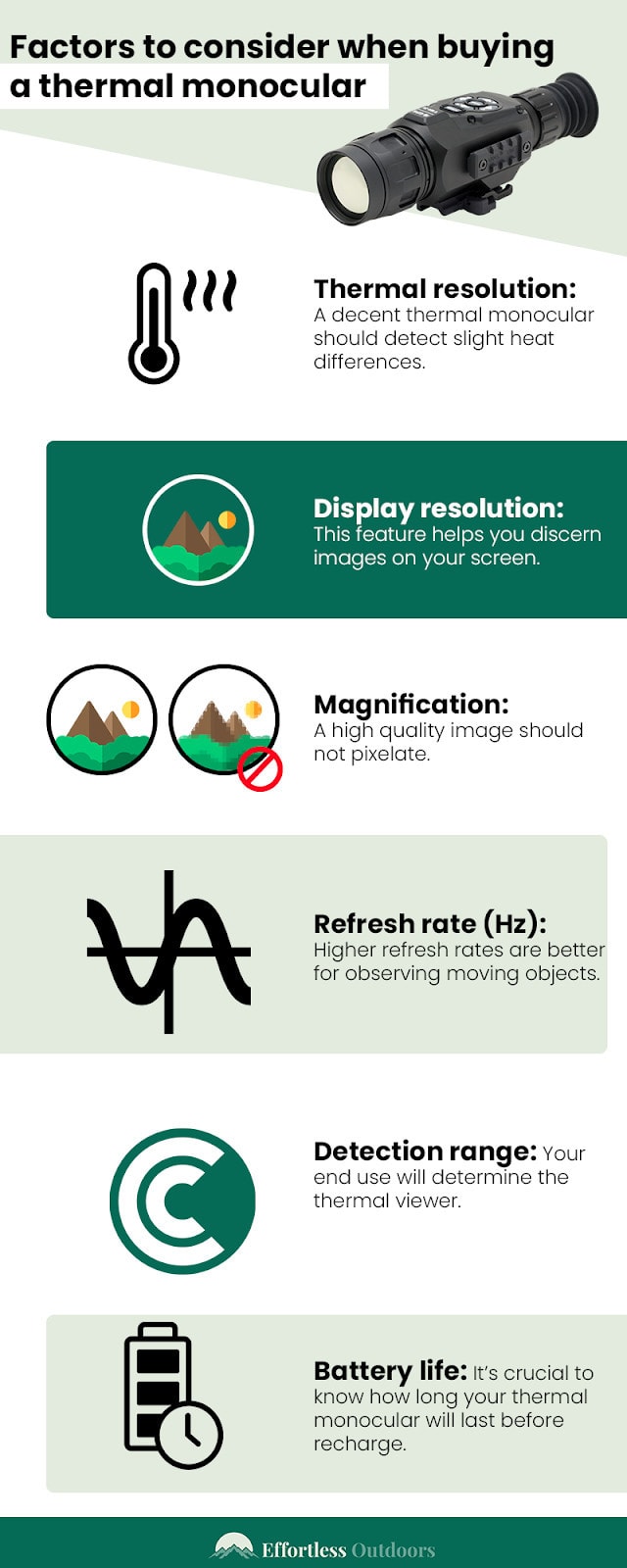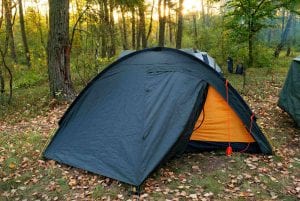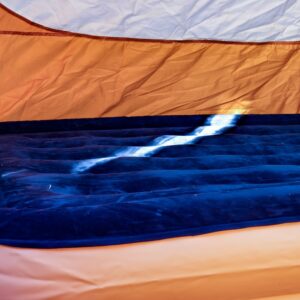I resisted a thermal monocular for hunting for ages, worried that it might be cheating. But then I cracked and now there’s no going back!
(This article is mostly concerned with the best thermal monocular for hunting. Of course other uses include law enforcement, search and rescue missions, marine iceberg detection, and site-building analysis. You’ll probably find the reviews useful regardless of the intended application).
In this article will help you find the best thermal monocular for the money.
Want to cut to the chase? Here’s a rapid run-down.
The best value thermal monocular is likely going to run you north of $1,000. Anything under $1,000 falls into the budget range IMO. (There’s good tech to be had in the budget range but you get much better bang for your buck in the $1,000-$2,000 range). Anything over a couple of grand I’d put in the “high end” category.
- I reckon the best thermal monocular for the money is the Pulsar Axion 2 XQ35. (The Pulsar Axion 2 XM30F is a solid, lower-spec alternative and the XG35 is a decent upgrade if you want it to be wifi enabled). Whichever version you choose, you’re not going to be disappointed.
- If you can’t stretch your budget that far then the best budget thermal monocular is probably the FLIR Scout TK Mini (although the AGM Global Vision Asp-Micro gives it a fair run for its money). That said, I’d class these budget thermal monoculars as “recreational”. I think if you plan any serious use, you’d probably be a bit disappointed you didn’t go for something higher spec.
- If you want to go really high-end then I’d suggest looking at Pulsar again but going for something in the “Helion 2” range. Really amazing quality; delivering clarity at long distances and boasting incredible battery life.
Need more detail? Please read on!
Best Thermal Monocular for the Money
I reckon the Pulsar Axion 2 Series is brilliant and are the best handheld thermal monoculars when you balance price against performance. The XM30F is the budget version in the range. The XG35 is the pimped up version with wifi. And the XQ35 is the real workhorse in the middle.
Specs
| XM30F | XQ35 | XG35 | |
| Advertised Range | 1040 yards | 1200 yards | 1900 yards |
| Actual Useful Range | 600 yards | 800 yards | 1,000 yards |
| Magnification | 3-12 (4x zoom) | 2-8 (4x zoom) | 2-8 (4x zoom) |
| Resolution | 320×240 pixels | 384×288 pixels | 384×288 pixels |
| Frame Rate | 50 Hz | 50 Hz | 50 Hz |
| Weight | 8.8 ounces | 12.3 ounces | 10.5 ounces |
| Battery Life | 4 hours | 11 hours | 11 hours |
The Pulsar Axion 2 XQ35 is a heavyweight compared to cheap thermal monoculars like the FLIR Scout TK. In particular you’re looking at better resolution and greater magnification. Given it has a detection range of up to 1,400 yards, the Pulsar Axion is ideal for short and long-range animal scouting and spotting.
It has an optical and digital zoom, perfectly designed to observe animals from a safe distance. Optical zoom is 2x, and is supplemented by 4x digital zoom.
While zooming, you can engage the Picture in Picture mode. Thus, you can magnify your target through a small window at the top of the display while still ensuring the subject of interest stays in clear view.
Unfortunately, the 320 x 240 thermal sensor doesn’t have the highest thermal imaging resolution. However, it meets the average user’s expectations. The only time its limitations will seem extreme is when you zoom in too much, the image becomes foggy.
Thankfully, the Axion Axion 2 XQ35 has an internal memory of 16GB, meaning you can still enjoy taking photos and record videos whenever you want. Typically, the 3200 mAh battery can last up to four hours before requiring more power. Ensure you use the USB cable provided to recharge it.
When it comes to its construction quality, the Axion Axion 2 XQ35 can withstand rugged environments while being easy to carry around. However, don’t be fooled by its delicacy; it has a rigid aluminum body and an IPX7 waterproof rating.
Although the XQ35 has a better resolution than the Scout TK, it is still limited in image quality. As previously mentioned, the 320 x 240 resolution is inadequate when it comes to zoom features. You’re better off moving closer to your target than solely relying on zooming.
Its hefty price tag, which is more than three times the Scout TK price, can also deter newbies. So, if you are working with a tight budget, this thermal scope might not be an excellent fit for you.
Pros
- Long detection range.
- Waterproof (IPX7).
- Video and photo recording.
- Compact and lightweight.
- High magnification for long-range spotting.
- It supports live streaming.
Cons
- Pricey.
- Fair resolution.
Final Verdict
Despite its cost, the Axion 2 XQ35 has excellent optics, a live streaming capability, rugged and lightweight construction, making it worth every dime. However, seasoned hunters, especially, will be disappointed by this variety as they’ll want to see further than 100 yards.
Where To Buy…
- Check it out on Amazon >>
- Check it out at Optics Planet >>
Best Thermal Monocular Under $1000
FLIR Scout TK
The FLIR Scout TK is the best thermal monocular for up to 100 yards’ visibility. It is ideal for beginners looking for an affordable thermal scope for elementary hunting and animal spotting. Its compact and pocket-friendly design makes the FLIR Scout TK easy to carry around.
Albeit limited, its viewing range is decent, thus allowing you to discern large animals in landscapes. You’ll need to be much closer to the subject to differentiate between smaller creatures like butterflies, rats, and owls. Its resolution is also on the lower side of the spectrum.
The 160 x 120 thermal sensor produces good quality images, but only at close range. This limitation explains why the FLIR Scout TK’s detection range is limited to 100 yards. Beyond this, the resulting image gets too fuzzy.
One of FLIR Scout TK’s best features is its portability. It weighs only 6 ounces and can fit in your pocket. You will also be impressed with the FLIR Scout Tk’s photo and video capability. You get to enjoy multiple color palettes when taking pictures or recording videos.
The FLIR Scout TK comes with a multi-purpose USB cable that allows you to transfer media to other devices and charge the scope. The Lithium-ion battery gives you about five hours of continuous use.
The FLIR Scout TK suffers from imaging performance overall, which is not surprising for an entry-level thermal imaging monocular. The refresh rate, resolution, and detection range are all on the lower side. Due to the low resolution, the Scout TK has no magnification, as zooming in would significantly distort image clarity.
If you want a high-resolution, high-magnification thermal imaging monocular that can spot distant animals, the Scout TK might not be ideal for you.
Pros
- Great for close to mid-range animal viewing.
- Compact and light in weight, making it a great handheld thermal monocular.
- Multiple palette options are available.
- Great for taking photos and videos.
- Fairly priced.
Cons
- Relatively low resolution.
- Zero magnification.
- Its poor video refresh rate value means it’s not ideal for observing moving objects.
Final Verdict
While it has plenty of limitations, the FLIR Scout TK is good for close to mid-range animal spotting. Beginners will also appreciate its low price and ease of use.
Where To Buy…
- Check it out on Amazon >>
- Check it out at OpticsPlanet >>
- Check it out at Cabelas >>
AGM Global Vision Asp-Micro Short Range Thermal Imaging Monocular
This thermal monocular comes with an infrared detector, and an LCOS image display, producing crystal-clear imagery. The magnification is 1x to 4x digital zoom. The AGM Global Vision monocular can track targets, measure distance, as well as integrate Wi-Fi connectivity.
It also comes with inbuilt memory storage, image zooming and can conveniently mark hotspots in high temperatures. Despite the surprisingly fair price tag, you’ll enjoy a 3-year warranty and a battery life of approximately seven hours. On the flip side, AGM ASP-Micro thermal monocular has a relatively low refresh rate value – 25 Hz.
Pros
- Professionally built.
- Durability quality.
- Simple operation.
- Feature Wi-Fi connectivity.
- Target tracking.
- Distance measurement.
- Marks hotspots in high temperatures.
Cons
- Limited zooming.
- Slightly heavy.
Where To Buy…
- Check it out on Amazon >>
- Check it out at OpticsPlanet >>
Best Thermal Monocular for Coyote Hunting
This is a slightly tricky question because it depends a bit on the ground you’re hunting over. If you’re hunting big fields or wide open plains, you’ll probably want something with a relatively high base magnification to you can detect coyotes hundreds of yards away.
However if you are hunting timber, chances are you’ll have more success detecting critters with a thermal that has the widest field of vision possible because of how close in they’ll be.
Another big consideration is that a thermal monocular, while excellent at helping you detect animals, is unlikely to help you positively ID them. (Yes, an experienced hunter will probably have a really good feel for what they’ve detected but even they are unlikely to have a 100% positive ID using a thermal).
And so if you don’t already have a decent thermal scope for coyote hunting, you’re probably going to need one of those in addition to your thermal. And so you may well find your budget starts to get squeezed.
With all that said, I reckon your best thermal scanner for coyote hunting in fields and plains is the Pulsar Helion 2 XP50 (available from Optics Planet, Amazon, and Cabelas).
For timber and forest, I’d say the best thermal monocular for coyote hunting is likely to be the Pulsar Axion XM30 (available from Optics Planet and Amazon).
FLIR Breach PTQ136 Multi-Purpose Monocular
Fun Fact: The FLIR Breach PTQ136 is designed primarily for law enforcement use.
The integrated railing allows you to quickly mount it on a helmet for much-needed hands-free spotting for starters. When it comes to optics, the FLIR Breach falls in the mid-level performance range. Although it is better than most beginner thermal scopes, it has significant drawbacks.
The 320 x 256 thermal sensor resolution, for example, delivers a reasonably clear image. However, you’ll need to be pretty close to the target. A detection range of about 225 yards is fair for observing a person and other large creatures. As for smaller animals, you will need to be approximately 100 yards away to get a clear image.
FLIR Breach has 1x-4x continuous digital zoom. However, despite giving you a close-up view, you’ll notice that zooming in will reduce your image quality. One optical feature you’re sure to enjoy is the high refresh rate value (60 Hz).
This multi-purpose thermal monocular can record up to 2.5 hours of video and take as much as 1000 still images. As with most electronic devices, it’s crucial to use the provided USB cable for all your media transfers. You should avoid uploading pictures directly to your browser to protect your night vision monocular from malware.
With a meager weight of just 7.4 ounces and a compact design, the FLIR Breach is easy to carry around. On the flip side, this thermal monocular is not designed for long-range observations. Most users report a modest range of about 200 yards for most subjects, less for smaller ones.
Another drawback to this thermal monocular is its hefty price tag. FLIR Breach is not ideal for customers on a budget. Its battery life is also on the unimpressive side. Finally, the 90-minute continuous usage is less than most other thermal scopes.
Pros
- Ideal for spotting objects in close and mid-range view.
- It can be mounted on a helmet.
- Its high refresh rate guarantees steady images when you are on the move.
- Digital zoom.
- Good resolution.
Cons
- Pricey.
- Limited detection range.
Final Verdict
What makes the FLIR Breach suitable for law enforcement also makes it great in the woods. It has excellent optics, a lightweight design, and the option to mount it on a helmet.
Leupold LTO-Tracker HD Thermal Viewer
The Leupold LTO-Tracker HD comes highly recommended for use in cool night temperatures. It is during such conditions that it boasts the best contrast between the object of its surrounding. On much cooler nights, the detection range can go as far as 750 yards.
Be sure to use the 6x digital zoom to get a closer view of your target. The 320 x 240 thermal resolution is also relatively good. Although it provides decent image quality, you’ll have to be careful not to zoom in excessively. Although the CR123 battery offers up to three hours of continuous use, it is non-rechargeable.
A significant drawback to this thermal monocular is it does not allow video or image recording. The 25 Hz refresh rate is relatively slow, meaning the image can become choppy when observing a moving target.
Pros
- Great for night tracking/hunting.
- Multiple color palettes.
- 6x digital zoom.
- Lightweight and compact.
Cons
- No photo or video recording.
- Poor image quality when using digital zoom.
Final Verdict
The Leupold LTO-Tracker HD has several limitations. But since the price tag is reasonably fair, we still think this thermal monocular is ideal for beginners searching for an entry-level thermal scope for nighttime use.
FLIR Scout Thermal Imaging Monocular
If you’re looking for a one-of-a-kind thermal monocular, look no further than the FLIR Scout III 640. It’s significantly costlier than its counterpart – Scout III 320, meaning you’ll reap greater rewards from this newer model. For starters, its 1200 yards heat signature detection range makes it the perfect thermal monocular for hunting.
With a refresh rate of 30 to 60 Hz, users of FLIR Scout III models can enjoy crystal clear image quality. This includes predators in motion and people performing ordinary tasks like swimming and surfing. Consequently, this makes it one of the best thermal monoculars for outdoors sports fans and law enforcement experts.
Weighing only 12 oz, the FLIR Scout III comes in a rugged, waterproof casing that can withstand shallow water submersions. Its impact-resisting housing protects it from any physical damages like hard falls or impacts. It also comes with a wide rubber eye cup to prevent exposure by limiting display light leakage.
Another perk of using this HD monocular is its ability to view targets in low visibility environments, whether day or night. In addition to its dynamic vision, this night vision monocular can detect targets in glaring light. Despite having top-notch features, the FLIR Scout III is easy to set up, making it perfect for newbies.
Like the FLIR Scout III 320, this calibration model comes with a built-in 640 x 480 LCD display. It also comes with a handy wrist strap to support its handheld design. This way, users can utilize its recording features to their true potential without tiring quickly. Once done, you have the option of using a 320 or 640 video-out cable.
Pros
- Impressively fast startup.
- High refresh rate.
- High resolution.
- Can detect body heat 24/7.
- Waterproof casing with impact-resisting properties.
Cons
- Relatively expensive.
Final Verdict
If you don’t mind the absence of an SD card slot to store videos, then FLIR Scout III is ideal for you. Otherwise, this HD monocular only has excellent reviews.
Leupold LTO Quest Thermal Viewer
This thermal monocular is a beginner-friendly viewer for those who don’t want to splurge on a high-end scope. Its optics make it perfect for short-range spotting and hunting. Its thermal sensor has a 206 x 156 resolution, which is good enough to detect large animals even 300 yards away. For smaller targets, however, you’ll need to move much closer.
Instead of an eyepiece display like that on monocular and scopes, the Leupold LTO Quest displays the resulting thermal image on a 2.4″ LCD. Scrolling through the different button functions will reveal numerous exciting settings, including multiple color palettes.
Although you cannot record video on the Leupold LTO Quest, you can still take images. Before purchasing, it’s essential to note that the internal memory stores up to 2,000 photos.
The Leupold LTO Quest is powered by a rechargeable battery, providing you with almost four hours of continuous use. The recharg battery also powers an in-built 30-lumen flashlight, making it ideal for night camping and emergencies.
Pros
- Low price.
- Decent range.
- It can take and store images.
- On-screen temperature readings.
- It comes with a built-in flashlight.
Cons
- Low resolution.
- No magnification.
Final Verdict
The Leupold LTO Quest is an excellent thermal monocular for novice hunters. It is a reasonably affordable thermal imager with a decent optical performance to match.
ATN OTS HD 384 Thermal Monocular
For a relatively affordable price tag, the ATN OTS HD monocular delivers clear and sharp images. A 384 x 288 thermal sensor gives a clear view ranging up to 625 yards. A built-in 3D gyroscope will keep your shot steady and reduce shakiness.
This HD thermal monocular also comes with an integrated compass and rangefinder. It can also record HD videos and stream live recordings onto your smartphone. The ATN OTS HD operates on four AA batteries, giving you about 8 hours of continuous use.
Compared to other thermal monocular varieties, this one is relatively heavy, making it unfriendly for prolonged viewing.
Pros
- High image quality.
- Long detection range.
- HD video recording and streaming.
- Built-in rangefinder, compass, and gyroscope.
Cons
- It is heavy for a handheld thermal monocular.
Final Verdict
The ATN OTS HD 384 is a mid-range thermal monocular that’s great for high-quality optics at an affordable price.
Sector Optics T20x Thermal Imaging Monocular
The Sector Optics T20 thermal imaging monocular has a 60×80 resolution, and a battery backup time of four hours. It also delivers a decent field of view (up to 17 degrees) and can work at wider temperatures as well.
Its variable magnification ranges from 1x to 5.5x and a meager refresh rate of 9 Hz. If your focus is portability and not high-quality features, then this thermal monocular is ideal for you. Although this thermal imaging monocular is rigorous in performance, it has a short battery life of four hours.
Pros
- Very compact and portable.
- Lightweight construction.
- Easy-understand and simple layout.
- Decent operating temperature range.
- 17 degrees of field of view.
- Variable magnification.
- Inbuilt image enhancement.
Cons
- No connectivity options.
- Not for high-end applications.
- Short battery life.
Conclusion
Although thermal technology costs more than night vision, its diverse applications are undeniable. We highly recommend the FLIR Scout TK thermal monocular to beginners. However, the Leupold LTO Quest makes the cut as the first runner up to this tight race.
As for our mid-range pick, the Pulsar Axion Key XM30 provides a perfect balance between affordability and optical performance. Our high-end pick is the ATN ThOR 4 640 thermal monocular if you’re interested in the scope. We also suggest the ATN BINOX 4T 384 for those who prefer binoculars.
At the end of the day, only one thermal scope can win – the Pulsar Axion XM30. With such an impressive heat signature detection range of 1400 yards, not even the FLIR Scout models can compare. Its impeccable video recording and waterproof features are ideal for people who love viewing around water bodies.
Types of Thermal Imaging Devices
In most cases, a thermal imaging device scans images at a rate of 30 times every second. It can sense temperatures as low as -20 degrees Celsius to 2,000 degrees Celsius. Another impressive feature is their ability to detect even the slightest temperature changes. So, what are the two categories of thermal imaging devices?
Uncooled
You are more likely to find this variety in the market. Its infrared-detector elements are enclosed in a unit operating at room temperature. Other perks include an in-built battery and a noiseless system that activates immediately.
Cryogenically Cooled
Unlike uncooled systems, the cryogenically cooled variety is costlier and vulnerable to damage. Their elements come sealed in a container that cools them to below zero degrees Celsius.
As a result, you will enjoy incredible resolution and sensitivity. A cryogenically cooled monocular can observe even the slightest temperature changes (0.1 degrees Celsius) from more than 300 yards away. Such systems are recommended for seasoned hunters and other long-distance viewing thrill seekers!
How to Choose the Best Thermal Monocular
Given the wide selection of thermal monoculars in the market, you’ll need to consider several factors before purchasing one. And since the process is tedious and possibly confusing, here is a list of features to consider before getting started.
Price
An excellent thermal scanner for hunting is probably going to run you over $1,000 apiece. That said, be prepared to spend reasonably high rates. The best price depends on what kind of thermal optics you desire and the size of your wallet. As a novice, you won’t need ultra-high-resolution thermal monoculars as you set out. You can easily find a suitable thermal monocular for under $1,000.
Thermal Resolution
Since a thermal monocular can detect heat signatures via its thermal sensor, this thermal sensor’s resolution should be of high quality. The bigger your thermal resolution, the more sensitive the thermal monocular, thus translating into exceptional image quality.
An amateur-level thermal monocular possesses roughly 160 x 120 resolution, while a midrange monocular spots a 384 x 288 thermal sensor. The best thermal monoculars (high-end) have a resounding quality of 640 x 480.
Display Resolution
For an easily discernible image, a thermal imaging monocular must come with a decent lcd display resolution as well. It’s usually better than the thermal resolution, with the best screens denoted by 1280 x 720 pixels. The thermal resolution is upscaled to fit like a glove on the LCD display.
Magnification
Most thermal imaging monoculars also offer magnification capabilities. However, thermal magnification works differently than other precision scopes. Thermal scopes tend to distort or pixelate as you zoom in. As such, most don’t have as high a magnification power as actual glass.
The method of zoom is also vital to consider. It could be digital, optical, or a combination of the two. A terrific example of digital zoom devices is the smartphone camera. It works great for close targets. However, once you pass a certain threshold, you’ll experience a dramatic decrease in resolution.
Optical zooms are more precise and perform better for long-range targets since the actual lens focuses on delivering sharper images. Unfortunately, this is not as speedy or convenient as a digital zoom. There are plenty of options available that use a combination of both digital and optical zoom features.
Refresh Rate (Hz)
The speed at which the thermal imaging monoculars refresh the view you see best defines the refresh rate. For stationary objects, refresh rate has a negligible effect on what you see. The opposite effect comes into play when dealing with moving targets.
If your target is moving fast for your thermal monoculars’ refresh rate, you’ll see your target moving in short jumps. This difference comes from the lag your thermal imaging monocular experiences. Thermal monoculars are available with various refresh rates. 60 Hz is ideal, providing a faster video refresh rate and the most accurate image.
These handy features make it a great thermal monocular for hunting.
Detection range
This feature tells you how far you can spot a subject of interest using thermal monoculars. It spans 100 yards for beginner imagers to over 1,000 yards for a high-end model. At 1,000 yards, you may spot something warmer than the background. But to discern a gazelle from a car while sight-seeing or when hunting, you’ll need to be closer.
Detection range will be very effective for users interested in long-distance targets. If your thermal monocular can effectively manage over 200 yards and quickly detect heat signatures with clarity, it’ll be handy indeed. You can then use your hunting binoculars for proper ID.
Operating Temperature
The weather is pretty unpredictable, especially when out in the field. To keep your activities fool-proof, you’ll need to invest in a thermal monocular with a broader operating temperature range.
In most cases, you will find a great thermal vision monocular with a range of -20 to 50 degrees Celsius. Although you’ll typically work within this temperature range, you can still find more thermal monoculars built for extreme conditions.
Durability
If you are going for powerful optics, it’s crucial to consider the overall monocular durability. Your monocular is bound to be more vulnerable if it has bigger optics. Thankfully, the best thermal monoculars are both waterproof and shockproof. These handy features make them safe for adventures in the wild.
Color Modes
Like binoculars, thermal vision monocular come with various color modes as well. That said, it’s best to choose one that meets your requirements. The darker shades represent the objects emitting less energy and vice-versa for the brighter ones.
There’s also a more expansive color chart to choose from to cater to a person battling color blindness. Consequently, the additional colors provide buyers with variety.
Battery Life
Your thermal monoculars battery life is a critical factor to consider when working in the field. Like most devices, the more features you add to it, the shorter your battery’s life. For instance, Wi-Fi and Bluetooth connectivity consume power extremely fast. Some of the best thermal imaging monoculars come with a rechargeable battery.
Most thermal monoculars will typically last for five to six hours of operation. But some of the best thermal monoculars will allow up to 11 hours of continuous use (at least, according to the marketing departments).
If long battery life is paramount, you’ll probably have to compromise on dormant features. You can consider eliminating features like compass, rangefinder, and image stabilization software which are large consumers. Thankfully, smartphones come with equally superb inbuilt features.
You’ll also want to avoid a thermal imaging monocular that uses AA batteries. They are relatively expensive, and you’ll burn through them quickly. Instead, use lithium-ion batteries as they are easy to replace and charge.
Additional Features
With the impressive development of the optics field, manufacturers are introducing new features every day to improve the thermal imaging monocular. Unsurprisingly, these additional features that were once based on preferences have now become must-haves even for the average user.
Rangefinder
Rangefinders are a recently added feature, certainly the best thermal monocular models come with it pre-installed. Using a rangefinder, your distance measurement no longer has to be an estimate!
Wi-Fi and Bluetooth
Wi-Fi and Bluetooth features are preferable when recording videos or capturing images using the best thermal monoculars. Once done, you can directly share the files or can save them on the cloud. Wi-Fi lets you stream live images of what you see on a smartphone or tablet. This feature is vital for researchers gathering invaluable data on their fieldwork.
Color Palettes
Color thermal monoculars give different heat values to various objects and areas. These objects are then assigned a color for your view feed. You can also find monochromatic thermal monoculars that use grayscale. Such scopes display warmer objects as a lighter gray or white against a darker gray or black background.
Although colored thermal monoculars can be easier to differentiate minute details, a monochromatic thermal scope is easier on your eyes. It also performs almost as effectively and is much cheaper than color gradient scopes.
Thermal Imaging Applications
Here are some of the vast uses of thermal imaging.
- Home and building inspections: Thermal monoculars are ideal for spotting moisture damage, detecting poor insulation and gas leaks in buildings.
- Marine use: Military and commercial vessels use thermal monoculars to detect invisible icebergs, enemy ships, and warm bodies in the water.
- Electrical inspection: Electricians prefer them since they excel at locating overheating components hence remedying the situation before a tragedy occurs.
- Law enforcement: Law enforcement agencies such as police use thermal monoculars to track body heat from criminals on foot, in vehicles, and even those who are airborne.
- Security: CCTV thermal installations can see through the darkness and create 360-degree surveillance networks.
- Process: Engineers use thermal monocular to monitor production lines constantly to check for problematic components and overheating issues.
- Medical: Monoculars are also ideal for spotting tissue damage and fever conditions in both people and animals.
FAQs
What Is the Best Thermal Monocular for the Money?
The best thermal monocular for the money (in our opinion) is is the Pulsar Axion XM30. It’s not as expensive as the higher end thermal monoculars like the Pulsar Helion 2 XP50 which is amazing but expensive. And yet it does a great job for the vast majority of people.
What Is a Thermal Monocular?
A thermal monocular is a thermal imaging device that helps you detect heat. Unlike night vision, a thermal monocular can be used to good effect during the day or night. It is especially useful for detecting quarry when hunting.
What is the Best Thermal Monocular Under $1000?
The best thermal monocular under $1000 is either the FLIR Scout TK Mini or the AGM Global Vision Asp-Micro.
What is the Best Thermal Monocular Under $500?
We wouldn’t recommend spending less that $500 on a new thermal monocular as at that price you’ll just be buying an expensive toy. However, if you are looking to go 2nd hand, then the best thermal monocular under $500 is likely to be an old Pulsar model.
What is the Best Pulsar Thermal Monocular?
The best pulsar thermal monocular is the Pulsar Helion 2 XP50 with a detection range of over 2000 yards, great field of vision as well as 20x magnification and a bunch of cool features including a rangefinder.
What is the Best Thermal Monocular for Hunting?
The best thermal monocular for hunting is probably the Pulsar Axion XM30 because it does the job for most hunters without breaking the bank. Of course you can spend a lot more to buy a greater range of magnification and detection, in which case you might consider the Pulsar Helion 2 XP50.
Why Are Thermal Cameras So Expensive?
These cameras are highly priced because thermal imaging uses unique technologies that are not mass-produced, hence exclusive. Consequently, the best thermal imaging monocular can easily get to the higher end of the scale.
How Do You Camouflage Heat From Thermal Imaging?
Using the surrounding terrain is one option because a thermal imager can’t see through landscapes. You may also use a thermal blanket to block the heat signature since it has Mylar foil in it.
What Is Better: Thermal or Night Vision?
Night vision gathers light present in the environment. On the other hand, a thermal imager focuses on heat signatures. So in dark conditions, thermal imager outperforms its counterpart.
What Is the Cost of Thermal Imaging?
Although thermal imaging is expensive, you can find a thermal monocular under 500 if you compromise on a few features. A good quality high resolution monocular can be around $800 to $900, depending on optics and other additional features.
Can a Thermal Monocular They See Through Glass?
No, they can’t. When the thermal sensor tries to read temperature data, it doesn’t pick whatever is through the glass. Instead, it selects the reflected temperature coming off objects in the environment, in addition to the user’s body temperature.
Whereas glass allows visible light through, it’s designed to block IR light from passing through it. Thus, the glass turns into an infrared light mirror and reflects.
Can You Hide From Thermal Imaging?
Since thermal cameras don’t require visible light to create images, they are not affected by darkness or weather conditions. This handy trick should explain why hiding from a thermal camera is particularly complicated, especially if the cameras have a high specification.
As mentioned, thermal imaging can’t see through a glass, making a large glass sheet ideal for evading. Consequently, this would mean wearing an all-over glass suit if you had thermal cameras pointing in multiple directions.
What Is a Heat Signature?
The movement of atomic particles in all objects creates heat. That said, a heat signature refers to the temperature patterns around any object or creature within a space. Based on the current temperature patterns within an area, you can identify various high and low temperatures.
When you aim your thermal monocular towards an object, the device will absorb infrared radiation from the source and heats up. Due to this heat, a change occurs within the device’s electrical resistance. And with the measurement of that change, an image is created.
How Does Thermal Imaging Work?
Traditional night vision devices create an image from the light reflected by objects. Therefore, the quality of the image produced is dependent on the constant presence of surrounding ambient light. Great examples of such are light observed from the stars and moon.
A thermal imaging device creates an image using heat signatures. Thus, it can be used in total darkness and can allow users to see through smoke, dust, light fog, foliage, and camouflage. This increases your detection range.
A thermal sensor collects infrared radiation from the target object. Infrared-sensitive detectors then reproduce a temperature pattern of the subject of interest, also known as a thermogram.
The thermogram is then converted into an electric signal processed by a circuit board into a display. The resulting image will appear in assorted colors depending on the intensity of the infrared emission. Since animals and people will be warmer than the environment, they’ll easily stand out.






